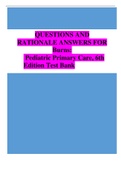3.
A school-age child with asthma is seen for a well child checkup and, in spite of “feeling fine,” has pronounced expiratory wheezes, decreased breath sounds, and an FEV1 less than 70% of personal best. The primary care pediatric nurse practitioner learns that the child’s parent administers the daily medium-dose ICS but that the child is responsible for using the SABA. A treatment of 4 puffs of a SABA in clinic results in marked improvement in the child’s status. What will the nurse practitioner do? a. Have the parent administer all of the child’s medications.
b. Increase the ICS medication to a high-dose preparation.
c. Reinforce teaching about the importance of using the SABA.
d. Teach the child and parent how to use home PEF monitoring.
Respuesta: ANS: D Home PEF monitoring is useful for children to identify when symptoms are worsening. This child does not appear to notice the presence of airway tightness or wheezing and so might benefit from PEF monitoring to know when to use the SABA. School-age children should be learning how to manage their chronic disease, so having the parent administer all medications is not the best choice, especially since use of the SABA is still dependent on the child’s report of symptoms. Since the child responded well to administration of the SABA, increasing the dose of ICS should not be done unless better management is not effective. Reinforcing the teaching is part of the plan but, unless the child is aware of symptoms, may not occur.




